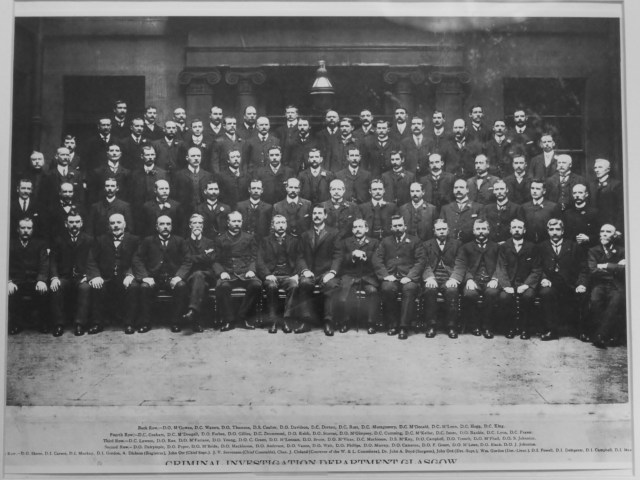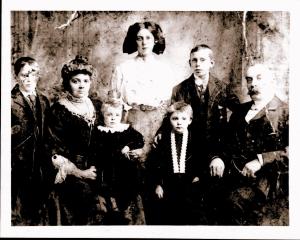William Thomson was born 31 Jan 1860 in Marnoch, Banffshire, Scotland to Alexander Thomson and Janet Reaper. At the tender age 11 per the 1871 census, he was working at a neighboring farm as a servant, not uncommon during this time. In 1881 we find him now living in Glasgow, Scotland as a Police Constable. He is boarding with Ann McIlwraith at 6 Waterloo St., Chalmers District of Glasgow. In 1891, William is still a Police Constable, he had married Christina L0w Sim on 18 Dec 1889 in Glasgow, they and their first son Alexander age 5 months are living in the Chalmers District but now on 11 Henrietta St., Glasgow. Christina dies on 17 Aug 1903 from Phthisis after giving birth to Helen in 1894, William in 1896 and James in 1898.
Back row, third from the left is William Thomson. This was the opening of the Criminal Investigation Department in Glasgow, Scotland dated 1904.
William married my great-grandmother Margaret Laidlaw on 16 Mar 1905 in Finlay Place, Newmains, Scotland. My great-grandparents had my great-aunt Margaret (Peggy) Smith Thomson b. 29 Jul 1906 and my grandmother Janet Raper Thomson b. 16 Dec 1907 in Glasgow.
William become a Detective before 1904 as proven in the photo of the 1904 Criminal Investigation Department, which was newly established right before this photo was taken. I obtained the department photo on my trip to Scotland in June of 2005 when I visited the Glasgow Police Museum. It was so wonderful to visit and actually see my great-grandfather on the wall of the museum in this photo, can't tell you the chills I have felt whenever I look at it. This is what genealogy can do for you. It's something like this that justifies your research, gives it definition, makes the ancestors real!
This is a photo of his actual Glasgow Police baton that had been used, it is bowed. There was a leather wrist strap, but due to age, it has broken off. It has the VR initials on it with Queen Victoria's Insignia I believe, so that dates it to before 1901 when Queen Victoria dies.

William retired from the Glasgow Police before 1920 because of poor health. The family was vacationing on the isle of Bute, when William was stricken down from a Cerebral Haemorrhage whilst playing golf. He was taken to 8 Columshill Place, Rothesay where they were staying and he passes away there. Margaret and the family take William back to Glasgow via ferry, apparently someone had been sitting on William's coffin when my grandmother, Janet then 12, asked them to please get off her father. I found that quite thought-provoking that the family would be returning with the deceased and my grandmother a small but feisty gal would tell someone to get off her father. When I asked my grandmother, in later years, where her father was buried, she had no idea. I can understand as it had been many years and she was just a young girl at the time. I have searched for many years to find his resting place. Last year while attending RootsTech2013 in Salt Lake City, Utah, I was digging around in the Family History Library and noted a film on burials in Glasgow. I never had seen this one before, so ever hopeful, I started in. It was indexed and wow, there it was, Sandymount Cemetery in Glasgow, William Thomson age 60, died in Rothesay, Burial in lair 626. I was so thrilled. Now I just need to get back to Glasgow to view his resting place. This bit on the finding of the burial can be read at my blog: http://scottishgenealogybycathy.blogspot.com/2012/02/grandfather-william-thomson-dies-at.html
reprint of my 52 Ancestors in 52 weeks at http://elusiveancestorhunter.wordpress.com/2014/01/07/blog/



